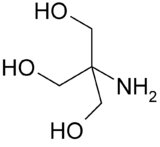Tris
 | |
| Names | |
|---|---|
| Preferred IUPAC name
2-Amino-2-(hydroxymethyl)propane-1,3-diol | |
| Other names
TRIS, Tris, Tris base, Tris buffer, Trizma, Trisamine, THAM, Tromethamine, Trometamol, Tromethane, Trisaminol | |
| Identifiers | |
3D model (JSmol) |
|
| ChEBI | |
| ChEMBL | |
| ChemSpider | |
| ECHA InfoCard | 100.000.969 |
| KEGG | |
PubChem CID |
|
| RTECS number | TY2900000 |
| UNII | |
| |
| |
| Properties | |
| C4H11NO3 | |
| Molar mass | 121.14 g·mol−1 |
| Appearance | White crystalline powder |
| Density | 1.328g/cm3 |
| Melting point | >175-176 °C (448-449 K) |
| Boiling point | 219 °C (426 °F; 492 K) |
| ~50 g/100 mL (25 °C) | |
| Acidity (pKa) | 8.07 |
| Pharmacology | |
| B05BB03 (WHO) B05XX02 (WHO) | |
| Hazards | |
| Main hazards | Irritant |
| Safety data sheet | External MSDS |
| R-phrases (outdated) | R36 R37 R38 |
| S-phrases (outdated) | S26 S36 |
| NFPA 704 | |
| Flash point | Non-flammable |
Except where otherwise noted, data are given for materials in their standard state (at 25 °C [77 °F], 100 kPa). | |
| Infobox references | |
Tris, or tris(hydroxymethyl)aminomethane, or known during medical use as tromethamine or THAM, is an organic compound with the formula (HOCH2)3CNH2. It is extensively used in biochemistry and molecular biology as a component of buffer solutions[1] such as in TAE and TBE buffers, especially for solutions of nucleic acids. It contains a primary amine and thus undergoes the reactions associated with typical amines, e.g. condensations with aldehydes. In medicine, tromethamine is occasionally used as a drug, given in intensive care for its properties as a buffer for the treatment of severe metabolic acidosis in specific circumstances.[2][3] Some medications are formulated as the "tromethamine salt" including hemabate (carboprost as trometamol salt), and "ketorolac trometamol".[4]
Buffering features
The conjugate acid of Tris has a pKa of 8.07 at 25 °C, which implies that the buffer has an effective pH range between 7.1 and 9.1 (pKa ± 1) at room temperature.
Buffer details
- The pKa declines approximately 0.03 units per degree Celsius rise in temperature.[5][6]
- Silver-containing single-junction pH electrodes (e.g., silver chloride electrodes) are incompatible with tris since an Ag-tris precipitate forms which clogs the junction. Double-junction electrodes are resistant to this problem, and non-silver containing electrodes are immune.
Buffer inhibition
Preparation
Tris is prepared industrially by the exhaustive condensation of nitromethane with formaldehyde under basic conditions (i.e. repeated nitroaldol reactions) to produce the intermediate (HOCH2)3CNO2, which is subsequently hydrogenated to give the final product.[9]
Uses
The useful buffer range for tris (7–9) coincides with the physiological pH typical of most living organisms. This, and its low cost, make tris one of the most common buffers in the biology/biochemistry laboratory. Tris is also used as a primary standard to standardize acid solutions for chemical analysis.
Tris is used to increase permeability of cell membranes.[10]
Medical
Tris (usually known as THAM in this context) is used as alternative to sodium bicarbonate in the treatment of metabolic acidosis.[11][12]
See also
References
- ↑ Gomori, G., Preparation of Buffers for Use in Enzyme Studies. Methods Enzymology., 1, 138-146 (1955).
- ↑ Stanley, David; Tunnicliffe, William (June 2008). "Management of life-threatening asthma in adults". Continuing Education in Anaesthesia, Critical Care & Pain. 8 (3): 95–99. doi:10.1093/bjaceaccp/mkn012. Retrieved 21 July 2017.
- ↑ Hoste, Eric A.; Colpaert, Kirsten; Vanholder, Raymond C.; Lameire, Norbert H.; De Waele, Jan J.; Blot, Stijn I.; Colardyn, Francis A. (May 2005). "Sodium bicarbonate versus THAM in ICU patients with mild metabolic acidosis". Journal of Nephrology. 18 (3): 303–307. ISSN 1121-8428. PMID 16013019.
- ↑ BNF 73 March-September 2017. British Medical Association,, Royal Pharmaceutical Society of Great Britain,. London. ISBN 978-0857112767. OCLC 988086079.
- ↑ El-Harakany, A.A.; Abdel Halima; F.M.; Barakat, A.O. (1984). "Dissociation constants and related thermodynamic quantities of the protonated acid form of tris-(hydroxymethyl)-aminomethane in mixtures of 2-methoxyethanol and water at different temperatures". J. Electroanal. Chem. 162 (1–2): 285–305. doi:10.1016/S0022-0728(84)80171-0.
- ↑ Vega, C.A.; Butler, R.A.; et al. (1985). "Thermodynamics of the Dissociation of Protonated Tris(hydroxymethy1)aminomethane in 25 and 50 wt % 2-Propanol from 5 to 45 °C". J. Chem. Eng. Data. 30 (4): 376–379. doi:10.1021/je00042a003.
- ↑ Desmarais, WT; et al. (2002). "The 1.20 Å resolution crystal structure of the aminopeptidase from Aeromonas proteolytica complexed with Tris: A tale of buffer inhibition". Structure. 10 (8): 1063–1072. doi:10.1016/S0969-2126(02)00810-9. PMID 12176384.
- ↑ Ghalanbor, Z; et al. (2008). "Binding of Tris to Bacillus licheniformis alpha-amylase can affect its starch hydrolysis activity". Protein Peptide Lett. 15 (2): 212–214. doi:10.2174/092986608783489616. PMID 18289113.
- ↑ Markofsky, Sheldon, B. (15 October 2011). Nitro Compounds, Aliphatic. Ullmann's Encyclopedia of Industrial Chemistry. 24. p. 296. doi:10.1002/14356007.a17_401.pub2. ISBN 978-3527306732.
- ↑ Irvin, R.T.; MacAlister, T.J.; Costerton, J.W. (1981). "Tris(hydroxymethyl)aminomethane Buffer Modification of Escherichia coli Outer Membrane Permeability". J. Bacteriol. 145 (3): 1397–1403.
- ↑ Kallet, RH; Jasmer RM; Luce JM; et al. (2000). "The treatment of acidosis in acute lung injury with tris-hydroxymethyl aminomethane (THAM)". American Journal of Respiratory and Critical Care Medicine. 161 (4): 1149–1153. doi:10.1164/ajrccm.161.4.9906031. PMID 10764304.
- ↑ Hoste, EA; Colpaert, K; Vanholder, RC; Lameire, NH; De Waele, JJ; Blot, SI; Colardyn, FA (2005). "Sodium bicarbonate versus THAM in ICU patients with mild metabolic acidosis". Journal of Nephrology. 18 (3): 303–7. PMID 16013019.
